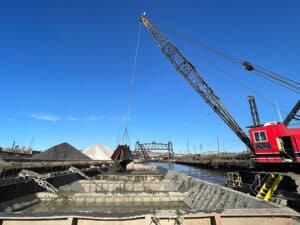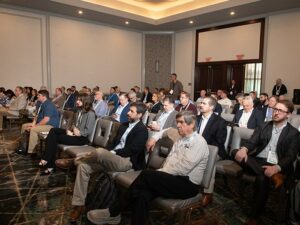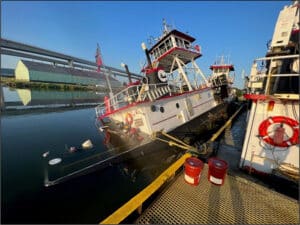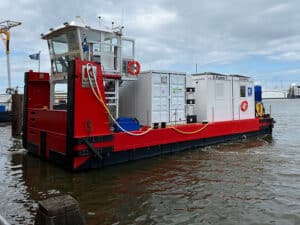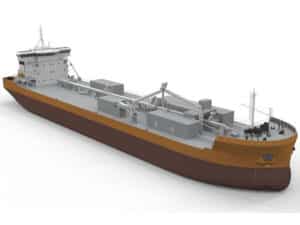
Op-Ed: Top 4 tips on how U.S. ports can claim $3 billion Clean Ports Program grant
Written by
Tunley Environmental chief scientist Rob Moorcroft
At the end of October the U.S. Environmental Protection Agency (EPA) gave stakeholders a “first look” at its plans to implement a new $3 billion port emission reduction program. During a webinar EPA staff provided an outline of the newly named “Clean Ports Program,” which was authorized in the Inflation Reduction Act of 2022 (IRA) as the “Grants to Reduce Air Pollution at Ports Program.”
The EPA expects to issue a Notice of Funding Opportunity (NOFO) in February-March, 2024, with final awards by the end of the year. The entire $3 billion will be distributed in a single solicitation and award cycle.
How can ports best position themselves to pitch for the grants on offer? Here, Tunley Environmental chief scientist Rob Moorcroft gives his top tips. Tunley is a specialist environmental consultancy. It is presently working with Detroit/Wayne County Port Authority on a 2040 zero carbon plan.
1) Start preparing now and review your emissions starting point
There is an urgency to the bid process with the NOFO expected in the new year. Ports serious about pitching for funding need to get their case in order quickly.
Key is to bring your c-suite on board and fully briefed on the opportunity. Senior management will need to ensure the bid team gets all the help it can to move quickly.
You then need to establish your starting point. U.S. ports will be at different stages of readiness. Some ports will have total operational control of their terminals, a baseline emissions inventory, and some decarbonization measures in place. Other ports meanwhile will have little control over private terminals and limited emissions inventory. For ports in this very early stage our advice would be to pitch for the planning grants, see below.
But if your port has already started on the decarbonization pathway then you could pitch for the zero-emission technology (ZET) grants. However, to maximise your chances of success it is vital to robustly review your emissions baseline inventory.
An emissions baseline is the reference point against which a port’s greenhouse gas (GHG) emissions will be measured going forward. Baseline emissions are calculated by looking at a ‘baseline emissions period’, usually the past one—five years of an organization’s activity. If no action is taken to reduce emissions and activity levels stay the same, this is the level emissions are expected to remain.
Once you have your inventory detailing all the equipment and activity which creates emissions you can work out how you can tailor your grant bid to your specific operations. It will be important to have a clear net zero plan with specific time-bound objectives ideally produced by a specialist adviser. That adviser needs to understand the science and the grant process.
Although every port is different as a measure of the work potentially involved Tunley has spent nearly 12 months pulling together the Port of Detroit /Wayne County Port Authority baseline emissions inventory and 2040 zero carbon plan.
In this case the project took time due to the complex ownership structure of the terminals. However, if your port owns its terminals then the collection of raw emissions data can be much quicker. In this case you could build a case for a ZET grant at speed as you could compile an emission inventory and zero carbon plan in time for the NOFO in February/March. But our advice would be to kickstart the process now as time is very tight.
2) Target the grants to your emissions pain points
The big funding available is the ZET grants. EPA staff said they intend to fund a handful of mega projects in the $200-$500 million range. They will also fund many smaller projects but they will need to be at least $10 million in cost. The agency has not yet announced a cost share requirement but is thinking of a 10%-20% non-federal cost share.
The law stipulates that funds must be used to purchase or install zero-emission port equipment or technology. The equipment/technology must be used at a port. Funds can also be used for planning related to equipment/technology purchase and installation.
Eligible recipients are port authorities, state or local governments that have jurisdiction over a port, an air pollution control agency, or a private entity that is partnered with one of the above.
Our advice is to look very carefully at what ZET equipment is most suited to your operations which can solve your emissions pain points. Low hanging fruit includes investing in retrofit or replacement of diesel powered trucks, quay cranes and goods handling equipment. This will pay huge dividends as the operational costs of electric equipment are far lower with op-ex savings estimated to be as high as 50 per cent. So with the grant contributing to the capital expenditure, there is huge scope for carbon reduction, cost reduction, and improving air quality.
Another big opportunity is to tackle ship emissions, often one of the biggest causes of port emissions. Shore power has been successfully employed at the Port of Los Angeles for a number of years, allowing vessels to operate their non-propulsion “hotel” electricity load using grid energy, rather than by running their diesel powered engines.
Ship to shore power works well for long dock times, especially for cruise ships and can have huge benefits for air quality where ships are docked.
The best results however, will vary from port to port, hence the importance of carrying out a baseline assessment. This will identify what the prime sources of your emissions are and where you should target your grant application for maximum impact.
3) Demonstrate community engagement
The EPA repeatedly stressed in its briefing that community engagement will be required for all successful grant applications with an emphasis on environmental justice communities.
Our advice is to show you have meaningful communication with the families, businesses and organizations living and operating near the port. Show evidence of correspondence, surveys and meetings with clear minutes and actions. You must show you are listening, sharing information and have clear intent to make air quality and emissions improvements. Even if carbon measures are still to be put in place the key is to demonstrate you are engaging the community and are planning to action positive change. Tunley has seen this done effectively with Southwest Environmental Vision (SDEV) in Detroit. We would advise port authorities to start building relationships with such community groups now, in readiness for a successful grant application.
4) Planning grants suited to ports starting low carbon journey
As advised ports must be realistic about their starting point. If a port has no emissions inventory baseline and a complex ownership structure where terminals may be independently owned and operated it may be tough to apply for the bigger ZET grants in a short time frame.
In this case the EPA is accepting planning applications of up to $3 million per application for creating a baseline emissions inventory and air quality indicators mapping out a net zero plan, stakeholder engagement and community engagement. In our experience working in Detroit this stakeholder engagement can take time but is the building block to pitching successfully for grant funding.
The American Great Lakes Ports Association has advised: “It is important to note that because there will only be a single funding round, those seeking planning grants will not have a future funding cycle in this program to pursue implementation grants. Federal assistance for implementation will have to be pursued from other federal programs or from non-federal sources. There is an option to pursue a joint planning/implementation grant from this program. However, such a strategy would require considerable advance preparation.”
Again working with a specialist would be key to pulling together a joint planning/implementation grant but you would have to move very fast. If a grant application is not realistic in the time frame, securing funding for a net zero plan will enable you to pitch for other funding. A specialist will be able to help identify alternative funding and grants for you.

